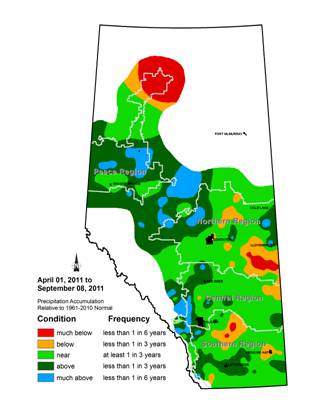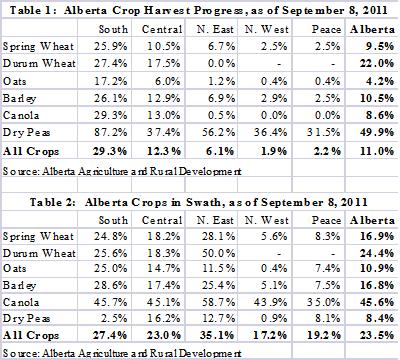| |
The excellent weather experienced across the province during the past two weeks has advanced crop maturity, and harvest is at various stages in all regions. Patches of light frost, with little or no crop damage, have been reported in all regions except Central. A few weeks of warm, dry weather without a killing frost are needed to bring crops to maturity, especially in the northern regions where crops are more delayed. Table 1 below presents estimates of harvest progress by region, while Table 2 presents the percentage of crops in swath.
Provincially, 11 per cent of the 2011 crop has been harvested, compared to less than two per cent two weeks ago. Most years, harvest is at 25 to 30 per cent. Additionally, 24 per cent of the crop is in swath, compared to five per cent two weeks ago, while 65 per cent of the crop is still standing. Harvest in the Southern Region is the most advanced, with 29 per cent of crops combined and 27 per cent swathed. The Central Region has 12 per cent of crops combined and 23 per cent swathed. Elsewhere in the province, with crop maturity a week to two weeks behind normal, harvest is just starting. In the North East Region six per cent of crops have been harvested, with 22 per cent in swath. The North West Region reports two per cent harvested, and 17 per cent swathed, while the Peace Region reports two per cent harvested and 19 per cent swathed.
Overall, provincial average yields are estimated to be above their 10-year averages, with good quality. For the majority of crops still standing, especially in northern areas, quality will largely depend on receiving warm, dry weather, without a killing frost, over the next few weeks.
Harvest of second cut hay is estimated to be 29 per cent complete on dryland, and 86 per cent complete under irrigation. The cool spring, and rain in early summer, generally delayed haying operations across the province. Some producers in northern areas are just completing the first cut operations. While hay yields are close to their 10-year averages, quality varies considerably, with much of the first cut either rained on, or cut late and over mature.
Pasture conditions in the province are rated as 10 per cent poor, 36 per cent fair, 30 per cent good and 24 per cent excellent. There are reports of moderate to over threshold levels of grasshoppers in the North East, North West and Peace Regions, as well as lygus bugs in the Peace Region.


Our thanks to Alberta Agricultural Fieldmen, staff of AFSC and the Alberta Ag-Info Centre for their partnership and contribution to the Alberta Crop Reporting Program.
Regional Assessments:
The 2011 Alberta Crop Report Series continues to provide summaries for the following five regions:
Region One: Southern (Strathmore, Lethbridge, Medicine Hat, Foremost)
- Excellent weather, with hot days and cool evenings, has harvest in full swing. Overall, about 48 per cent of cereal crops are standing, with 26 per cent in swath and 26 per cent combined. About 29 per cent of canola has been combined, with 46 per cent in swath and 25 per cent standing. More than 87 per cent of dry peas are in the bin. Yields for major crops are estimated to be above average, with good quality. Potatoes and dry beans are mostly still standing, and the sugar beet harvest has not yet begun.
- Second cut hay operations are nearly complete with the majority of hay rated as good to excellent quality, and yields at somewhat below average. Pastures are in generally fair to excellent condition.
- Surface moisture is rated at 47 per cent poor, 30 per cent fair, and 23 per cent in the good to excellent range. Sub-surface moisture is rated at seven per cent poor, 50 per cent fair and 43 per cent in the good to excellent range.
Region Two: Central (Rimbey, Airdrie, Coronation, Oyen)
- Although some crops are still ripening, warm weather over the past two weeks has advanced maturity and harvest is starting to progress. Light frost and rain showers have been reported in a few areas of the region. About 71 per cent of cereal crops are still standing, with about 18 per cent in swath, and 11 per cent combined. Nearly 42 per cent of canola is standing, with 45 per cent in swath and 13 per cent combined. Just over 46 per cent of dry peas are still standing, with 16 per cent swathed and 38 per cent combined.
- Major crop yields are estimated to be average to above average and quality so far is good. Re-growth in canola that was hailed on may cause some high green count grade reduction.
- A little over one-third of the second cut of hay has been baled, and while quality is good to excellent, yields are below average. Pastures are generally in fair to excellent condition. Surface and sub-surface moisture conditions are mostly rated as fair to excellent, with about seven per cent still rated as excessive.
Region Three: North East (Smoky Lake, Vermilion, Camrose, Provost)
- With the warm, dry weather over the past two weeks harvest is progressing in the southern portion of the region. In the north, where crops are more delayed, many cereals are being desiccated to try and speed ripening. Overall, about 69 per cent of cereals are still standing, with 25 per cent swathed and six per cent combined. About 40 per cent of canola is standing, with 59 per cent swathed and one per cent in the bin.
- Yields are estimated to be average to above average, and quality so far is reported as mostly good. There are some reports of small and shriveled kernels in wheat being harvested in the northern part of the region.
- Although some producers are still finishing up first cut haying operations, about 28 per cent of second cut operations are complete, with mostly fair to excellent quality, but below average yields. Pasture is rated at 27 per cent poor, 50 per cent fair and 23 per cent in the good to excellent range. Surface and sub-surface moisture conditions are generally rated as fair to good, although some eastern areas are reported as dry.
Region Four: North West (Barrhead, Edmonton, Leduc, Drayton Valley, Athabasca)
- Warm, dry weather over the past two weeks has advanced crop maturity, and harvest is getting underway. Just under 94 per cent of cereal crops are still standing, with four per cent swathed and about two per cent combined. About 56 per cent of canola is standing, with 44 per cent in swath. Yields are expected to be above average, and quality is good. Some of the uncut canola still has green pods and will need a couple of frost-free weeks before it can be swathed. Many producers have desiccated wheat to speed maturity.
- Second cut hay is about 10 per cent done, with average yields and mostly good to excellent quality. Pasture is rated as eight per cent poor, 46 per cent fair, 30 per cent good and 16 per cent excellent.
- Both surface and sub-surface moisture conditions are mostly rated as fair to excellent.
Region Five: Peace River (Fairview, Falher, Grande Prairie, Valleyview)
- Although many crops are behind, warm weather has moved them along and harvest is beginning. Many producers are desiccating to try and speed ripening. About 90 per cent of cereal crops are still standing, with eight per cent in the swath, and two per cent combined. About 65 per cent of canola is standing, with the rest being in swath. Dry peas are about 32 per cent combined, with 60 per cent still standing and eight per cent swathed. Yields are estimated to be near average. A few areas have reported light frost, but no damage.
- Second cut haying operations are 36 per cent complete, although some producers are still completing the first cut. Second cut yields are close to average, and quality is rated mostly good to excellent.
- Overall, surface moisture conditions are rated at one per cent poor, five per cent fair, 33 per cent good, 55 per cent excellent and six per cent excessive. Sub-surface moisture is rated at six per cent fair, 29 per cent good, 63 per cent excellent and two per cent excessive.
Note to Users: The contents of this document may not be used or reproduced without properly accrediting Alberta Agriculture and Rural Development, Economics and Competitiveness Division, Statistics and Data Development Branch. |
|